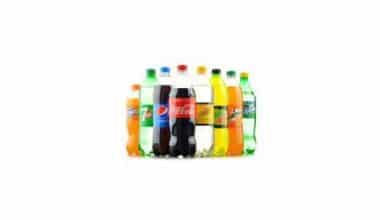Johnson & Johnson is a large American conglomerate with over 250 subsidiaries. It was founded in 1886 by three members of the Johnson family: Robert, James, and Edward. Today, the manufacturer provides products for hair, skin, and oral cavity care, as well as a variety of medical products and products for children’s and feminine hygiene. But did you know this brand’s logo has never changed since it first appeared in 1886? The management has never tried to redesign the Johnson & Johnson logo to avoid losing the industry recognition it has gained over the years. Let’s find out more…
Overview
Johnson & Johnson is one of those companies whose logo has always stayed the same. The signature of the company’s founder has been used as its sole emblem since its inception. It all started with a cheque signed by James Wood Johnson in 1886, and by 1887, the “Johnson & Johnson” inscription appeared on the product cans.
Though the first version of the iconic logo featured longer lines and wider loops of letters “J” and an ampersand between them, the lettering style we all know today is very close to the original.
The color palette of the brand’s visual identity was established in the 1950s, and before that, it was primarily executed in monochrome or blue and white. Though it can be seen in other colors today, the official color scheme of Johnson & Johnson is red and white.
Because there is no inclination, the cursive letters of the logotype look unique and exciting. It distinguishes and personalizes the entire emblem, adding a sense of trustworthiness, dependability, power, and energy, as reflected by the color palette.
The History of the Johnson & Johnson Logo
The Johnson & Johnson name appears in the script that resembles handwriting in the company’s logo.
Because the traditional design is so familiar and recognizable to consumers worldwide, the company chose a more straightforward, cleaner logo like most competitors. Deviating from it would have been too risky for the company.
Johnson & Johnson Logo Evolution
1886:
During the company’s first year of operation, co-founder James Johnson signed the company’s first official check, which included the company’s name written in the same way.
Johnson & Johnson’s first products, which medical practitioners used for sterile surgical procedures, featured a logo that resembled Johnson’s signature, with big loops on some letters and an ampersand connecting the first “Johnson” to the second.
1890:
The Johnson & Johnson logo first appeared on horse-drawn carts delivering products such as medicated plasters and first aid kits to local consumers in the 1890s.
1921:
As J & J’s business grew, Johnson’s handwriting was used in a new way—it was incorporated into the packaging design of their products, including a fresh baby cream. Simply put, Robert Johnson’s signature inspired the J & J logo still found on Johnson’s Baby Care products today.
The 1950s:
From the 1900s to the 1950s, J & J products had logos in various styles—some were very similar to the current J & J logo, while others looked like actual handwriting. However, beginning in the 1950s, Johnson & Johnson incorporated the symbol into its current packaging.
When China allowed Western businesses to set up shop there, the J & J logo appeared in Chinese on the company’s products, including BAND-AID® adhesive bandages.
In support of sustainability, Johnson & Johnson created a ground-breaking solution for its Neutrogena leftover lipstick containers in 2011. Lipstick walls depicting the company’s logo are now on display in seven J & J locations across the United States, China, and Brazil.
2016:
In 2016, Johnson & Johnson debuted an animated logo on the company’s redesigned website, giving the classic signature a modern twist.
Color and Font
The Johnson & Johnson visual identity’s custom typeface is entirely based on the original signature of James Wood Johnson, with which the company’s founder signed cheques and cans. Even though it has been slightly modified and strengthened, it still has that handwriting feel and an exceptional mood.
Johnson & Johnson LogoThe Johnson & Johnson logo’s typeface is similar to commercial fonts such as Adelica Brush Regular, Gelato Fresco Extra Bold, and Ollie. Still, with most lines modified and letters, contours narrowed.
Because of the condensed shapes of the letters, their straight and bold lines appear strict and professional. At the same time, the company’s bright official color palette makes the entire logo look friendly and welcoming.
The emblem for Johnson & Johnson’s visual identity is a bright and delightful combination of scarlet red and white. And this color palette evokes feelings of passion, strength, playfulness, and happiness.
The brand’s logo can sometimes be seen in a black-and-white color scheme or blue-on-white. The iconic inscription becomes more serious and stable, indicating the group’s professional qualities, expertise, and dependability.
What exactly is the Johnson & Johnson logo?
The name of the multinational corporation is written in an elegant red font that resembles calligraphic handwriting in the logo. The ampersand corresponds to the letter ‘J’ in the second word, ‘Johnson.’ The typeface’s closest match is Lelet Script.
What products does Johnson & Johnson manufacture?
Johnson & Johnson is the owner of over a hundred brands. These are medicines, medical equipment, and consumer goods such as a wide range of adult and child care products.
Is Johnson & Johnson a Swiss firm?
Johnson & Johnson is headquartered in New Brunswick, New Jersey, not Switzerland. The company is legally established in the United States.
What is J&J well-known for?
Johnson & Johnson is well-known for its pharmaceuticals. She is currently known as Janssen, the developer, and manufacturer of the COVID-19 vaccine.
Johnson & Johnson’s History
Johnson & Johnson was founded in 1886 in New Brunswick, New Jersey, by three brothers: Edward Mead Johnson, James Wood Johnson, and Robert Wood Johnson. The Johnson brothers were so moved by an address by antiseptic crusader Joseph Lister that they decided to establish a company that manufactures a variety of readymade surgical dressings.
The company’s first president was Robert Wood Johnson, and it was incorporated in 1887. Throughout the rest of the nineteenth century, Robert worked to improve sanitation practices.
J & J created the first marketable first aid kits in 1888, initially to assist railroad employees. However, the products quickly became the standard treatment for injuries. Johnson & Johnson began their heritage baby care product line with maternity kits in 1894. The kits were created to make childbearing safer for mothers and their children. Johnson’s Baby Powder, which went on sale the same year, was also a huge success.
Johnson & Johnson took another giant step forward in 1896 and 1897, creating the first mass-produced sanitary pads for women.
Read Also: Chick-Fil-A Logo: Everythiing You Should Know
Robert Wood Johnson died in 1910, and his brother James took over as president. James’ second son Robert Wood Johnson was elected president in 1932.
J & J subsidiary Ethicon manufactures wound closure devices and surgical sutures. It was established as a separate company in 1949 to diversify and expand the Johnson & Johnson product line. Following WWII, Ethicon sold 70% of the world’s surgical sutures, up from 15%.
Johnson & Johnson purchased McNeil Laboratories in America and Cilag Chemie in Europe in 1959. These two acquisitions aided the company’s first serious forays into the pharmaceutical medicine market.
A year later, under J & J, one McNeil product, Tylenol (the first-ever kid’s prescription aspirin-free pain reliever), became available over the counter. According to the company’s history, it became pediatricians’ and doctors’ most recommended pain reliever.
The Collaboration with Janssen
Janssen Pharmaceutica N.V. of Belgium joined the Johnson & Johnson group of companies in 1961. Today, Janssen is one of the world’s leading research-based pharmaceutical companies, selling prescription medications in fields such as women’s health, gastroenterology, mental health, HIV/AIDS, and neurology, to name a few.
Janssen is now divided into three separate businesses under the J & J brand name: Janssen Healthcare Innovation, Janssen Diagnostics, and Janssen Research & Development. Immodium (Loperamide), Alzheimer’s disease medicine Reminyl (Galantamine), and antipsychotic Risperdal (Risperidone) are among the most popular Janssen consumer products.
Johnson & Johnson in the 1970s and After
James E. Burke was the CEO and Chairman of Johnson & Johnson from 1976 to 1989. During this period, the company expanded into diabetes management, mechanical wound closure, and vision care. During this time, the company also established its first operating subsidiaries in Egypt and China.
Endo-Surgery from Ethicon assisted in the first ever minimally invasive surgery, which used very small incisions, in the 1990s. This type of surgery allows patients to heal faster than traditional surgery.
J & J invented the first coronary stent, known as the Palmaz-Schatz stent, in 1994. Coronary stents keep your blood vessels open, allowing blood to flow freely to the heart, so this advancement helped to revolutionize cardiology.
Cordis Corporation, another Johnson & Johnson company, later released the first medicine-eluting coronary stent, which helped prevent artery recoil. Cordis was founded in 1959 in Miami and develops and manufactures medical equipment for treating cardiovascular disease patients.
William C. Weldon became CEO and Chairman of Johnson & Johnson in 2002. Under his leadership, the company expanded into new therapeutic areas. When the company acquired Tibotec-Virco BVBA to meet the massive unmet needs of HIV/AIDS and tuberculosis patients, one of them was HIV/AIDS.
Johnson & Johnson paid $16.6 billion for Pfizer Consumer Healthcare in 2006. Leading global brands such as Listerine Oral Care and Nicorette smoking cessation products were included in the acquisition.
Today’s Johnson & Johnson
Alex Gorski was appointed CEO of Johnson & Johnson in 2012.
Today, the company has over 250 subsidiary companies operating in over 57 countries. Furthermore, its products are sold in over 175 countries worldwide. J & J concentrates on three main areas: consumer, diagnostics and pharmaceuticals, and medical devices.
J&J’s global sales were $67.2 billion in 2012, while research and development cost about $7.7 billion.
While it is impossible to predict how Johnson & Johnson’s future will unfold, the company’s pharmaceutical division has announced plans to develop ten new products in the near future. These products are designed to address critical unmet medical needs such as influenza, schizophrenia, and Hepatitis C.
Johnson & Johnson’s pharmaceuticals division was the fastest-growing pharmaceutical business in the U.S., Europe, and Japan in 2012.
Related Articles
- WHAT IS CASH CONVERSION CYCLE: How to Boost and Calculate CCC
- Holographic Will: How to Write Holographic Will, Explained!!!
- CSR (Corporate Social Responsibility): Definition, Types & Examples
- REAL ESTATE LAWYER: How to become a real estate lawyer guide( +Quick Tips)(
- BLUE CHIP STOCKS: Meaning, Characteristics &; How to Invest






